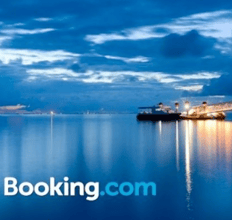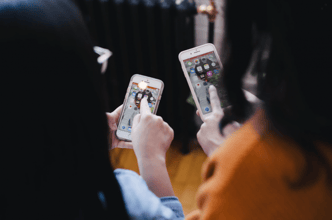Three-quarters of travellers start their hunt for a place to stay on a search engine (we’re looking at you, Google). While this is good to know, there’s one big problem. The rise of third-party booking sites (OTAs) has meant that they show up aggressively – and often – on search engines, leaving little room for your independent hotel and its website to stand out!
The rise in popularity of Booking.com over the past 10 years
You might have the best website in the world with the most seamless booking experience, but if it’s sitting pretty at the bottom of the search results, you’re going to see more tumbleweed than eager travellers coming through your digital doors. This is where your digital marketing strategy comes into play. Not only will it help you climb the search rankings to sit side-by-side with OTAs, you’ll have more control over your own booking process and how you engage with your guests.
On top of that, you can use your digital marketing strategy to drive drive direct bookings, which dramatically lowers your costs. Direct bookings take less than 5% commission, whereas OTAs take 15% or more in commission for each booking.
So, how do you create a digital marketing strategy that gets you more direct bookings? Here’s a step-by-step guide to get you started!
1. Know Your Audience and Your Message
It’s impossible to run a marketing campaign without a target in mind. Well, it’s not impossible, it’s just very, very likely to fail. This is why you need to know exactly who your audience is and keep them front-of-mind throughout the whole planning process! Without knowing who you want to reach, you won’t know what makes them tick, and what gets them sweaty-palm excited about a hotel.
You can’t be all things to all people.
By trying to be everything to everybody, you’re going to resonate with nobody. Start by creating customer personas. These are essentially detailed profiles of the kind of people you’re targeting with your marketing. The key here is to get really specific (like, uncomfortably specific). Instead of choosing to target “female travellers between the ages of 20 and 35”, you need to dig deeper and target a segment of that audience, like “single female backpackers who enjoy adventurous pursuits and are wanting to meet like-minded travellers while away.” As soon as you get to this level of detail, it’s much easier to determine what these kind of people might like to see from you, and what drives them to book a hotel! The next stage is figuring out your message (a.k.a. what you want to say). This is your brand message and will help you stand out amongst competitors.
If we take the female backpacker persona as an example, we can start to unpack their preferred method of communication and what kind of messaging hits them in the feels. Chances are, they’re more likely to resonate with a brand that’s fun-loving, casual, and friendly over one that’s more formal and serious.
A good way to see if your message is hitting the spot is to ask a focus group or someone who’s not involved with your brand for their honest opinion. Ask them if your message is clear, whether they feel the way you want them to feel when exposed to it, and whether your offers are really as compelling as you hope. You can also tap into reviews and customer feedback to improve your message so it fits directly with the needs of your target audience. For example, if you keep coming across a specific objection in your user reviews, you might want to address that in your messaging.
Keep in mind – the message you put out there ultimately impacts the kind of guests you attract. Both your customer personas and your messaging work in tandem to inform the rest of your digital marketing strategies. They help you decide where to reach your audience, what methods are best to use, and how you speak to those people.
2. Set Your KPIs and Iron Out the Details
Can you imagine getting on a plane and not knowing where you’re going? You wouldn’t know how long the flight takes; you wouldn’t know what clothes to pack; you wouldn’t know whether you needed a visa or not the other side. It would be a nightmare (unless you’re the kind of person who gets a kick out of things like that), and it’s the same if you have no end-goal in mind for your digital marketing.
To do this:
Define Your Overall Digital Marketing Budget
Knowing how much you have to spend is vital if you want to make sure you’re putting the right amount of time, effort, and money into the right marketing activities. For example, if you’re running Facebook Ads to attract new prospects, you’re going to need more budget for that than, say, email marketing towards the end of the sales funnel. It’s important that you strategically align your budgets with the right platforms and the different types of campaigns you have running at each stage of the sales funnel.
For hotel brands, seasonal campaigns are a must, and it’s likely you’ll need to allocate more budget for marketing activities at peak travel times. And, let’s face it, if you really want to grow, you’re going to need to invest in prospecting new audiences (which, it goes without saying, should be based on your persona profiles).
Seeing results from this kind of effort can take anywhere from three to six months, which is why it’s important to get the budget right at the beginning, middle, and end of campaigns like this. You’ll probably need to spend more at the beginning and then, as things start to pick up and engagement starts increasing, you can ease off a bit.
A look at the average cost per click of a Google Ad in the travel and hospitality industry.
If you have a limited budget, you need to ensure you’re getting the basics right and then build out from there.
Figure Out Your Goals and KPIs
KPIs (key performance indicators) help you measure what’s working and what’s not, and these will be driven by your goals. For example, if one of your goals is to get more visitors to your website, you might choose “conversion rate” as one of your KPIs.
Defining your goals is important, too. It’s easy to say “I want more bookings” and leave it at that, but how many more bookings and over what period of time? It can help to set SMART goals, which stands for Specific, Measurable, Achievable, Relevant, and Time-based goals! This means instead of having an arbitrary and, let’s face it, incredible vague goal of “getting more website visitors”, you’d have a more specific destination, like “increase website visitors by 20% in the second quarter”.
Dig Into Past Data
You don’t have to start your digital marketing plan from scratch. In fact, you’ve probably got a ton of useful information at your fingertips that can help you determine what activities have worked in the past!
Google Analytics
Look at tools like Google Analytics to see where most of your website visitors are coming from. If you’re getting far more people coming over from Facebook than LinkedIn, you know that you should be putting more effort into Facebook. You can also a tool like BuzzSumo to determine which pieces of content are performing the best, and of course, dig into channel-specific analytics like Facebook Insights and Instagram Analytics to see what’s performing best and generating the most engagement.
Instagram insights
Customer Experience Comes First
Everything you do in your digital marketing strategy should be geared towards your customers and providing them with a memorable experience. For instance, 90% of travellers expect a personalised experience when booking their travel. If you can provide a semblance of personal interaction in the direct booking process, you’re giving your customers what they want, which means they’re more likely to come back and book with you again!
Looking at stats like this and really getting to know your customers and what they want will help you create a bespoke digital marketing plan that delivers results for your hotel.
3. Monitor, Measure, and Tweak
As well as having your digital marketing plan, you also need a measurement and monitoring plan. This should ideally tie into your KPIs and your goals and should include the frequency of measurement as well as how you’re going to monitor your success. It’s important to remember that you might not see results immediately. For example, you’re unlikely to see results today or even over a couple of weeks on a big social media campaign. The key is to use every touchpoint you have with prospects to spark a connection, nurture the relationship, and build trust over time. At this point, you want to keep checking in on the success of the individual elements of your digital marketing strategy.
Separate out your different activities and then break those down further if you need to. For example, if you’re running a Facebook Ad campaign, monitor the reach, the cost per click, and the conversion rates separately rather than looking at them as a whole. This way, it’s far easier to see if something isn’t working. For example, a low reach on a Facebook Ad campaign might mean you’re targeting the wrong people, whereas a low conversion rate might mean your headline copy isn’t cutting the mustard.
Creating a successful digital marketing plan that continues to reap amazing results is a constant game of tweaking and then tweaking some more. Continue to go back to your persona profiles, your analysis of what’s already working and what’s not, and your budget allocation to see where you can best optimise everything you’re doing.
All Roads Should Lead to Direct Bookings
Direct bookings are your end goal, and the digital marketing activities you put in place help prospects get there. When 57% of hotel bookings happen online, it’s important that you’re in the places where people are making these bookings, whether that’s social media, Google, or somewhere else.
By following these three steps – from defining your audience and message, to setting goals, and measuring, monitoring, and tweaking – you’ll be able to optimise your digital marketing plan so that it consistently reaches the right people and nurtures them seamlessly through the sales funnel towards the holy grail – your direct booking engine!






